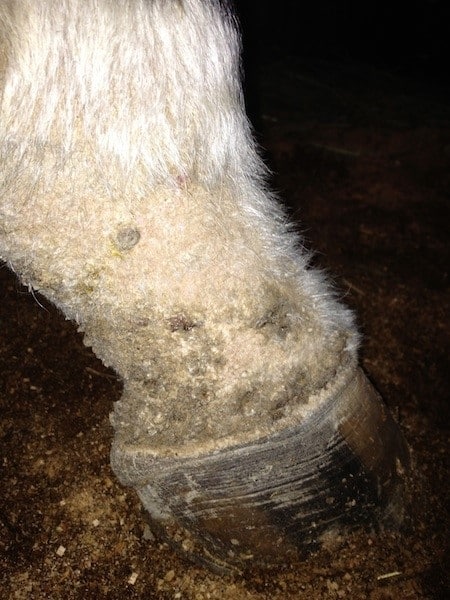Lymphangitis: A Frustrating Condition in Horses
- Topics: Article, Lower Limb, Other Skin Problems, Pain Management

Many horses will “stock up,” with subcutaneous edema (fluid swelling) in two or more legs (usually hind limbs). We see this minor problem frequently in horses that experience a significant decrease in exercise. Muscle contraction and elevated blood pressure are the typical forces that move blood and lymph fluid back toward the heart. The equine lower limb has no muscles to contract and, therefore, must rely on one-way valves in the vessels to hold the fluids and compression of the frog to impel them upward. Stocking up usually resolves with exercise.
Lymphangitis is dramatically different. The horse experiences abrupt or short-term (acute) onset of a hugely swollen leg (usually a hind leg), extreme pain (“three-legged lame”), and an elevated temperature (102-105° F). Frequently these horses will not eat—most likely due to the fever and discomfort—and will be obviously depressed, and some will tremble, breathe rapidly, and sweat. On examination, the limb will have “pitting edema” (when you squeeze it, you’ll see imprints of your fingers left in the tissue), and the horse will raise the leg so far up to avoid your touch that he could fall over.
Why does this occur, and what exactly happens? The veterinary community’s best educated guess is that a cut or even simple abrasion to the leg allows bacteria access. Often this is a Staphylococcus, Streptococcus, or Escherichia coli species. The bacteria reproduce quickly, causing the inflammatory reactions of heat and swelling as the body attacks its invaders. The lymphatic system drains fluid from the legs, filtering it through lymph nodes that try to remove foreign pathogens (disease-causing organisms). The lymph nodes are overwhelmed and can themselves become infected. Lymph ducts and blood vessels become damaged and swollen and lose their elasticity, with blood and lymph pooling on top of the one-way valves. The heart continues to pump fluid in, but the exits are blocked.
Within a few hours to days, fluid seeps through the most damaged areas of the tightly stretched skin. This serum can scald the epidermis or dry as clinging yellow crusts. Abscesses might develop under the skin as the body tries to wall off the assailants. When seen with ultrasound or as an obvious bulge on the limb, veterinarians will lance and drain these.
In an acute episode, aggressive antibiotics and anti-inflammatories are a must. Veterinarians often administer phenylbutazone (Bute) and flunixin meglumine (Banamine) to control pain and swelling. Cold water/ice might be useful as long as the leg is not left wet, which will only compromise the skin further. Intravenous dimethyl sulfoxide (DMSO) can be used as an additional anti-inflammatory. Corticosteroids (e.g., dexamethasone) and diuretics (which increase urine production) might also help draw out the swelling.
The most challenging part of treatment is getting the extremely painful horse to move. Again, movement is necessary to help promote fluid to travel back up the leg. These horses will resist walking, even though it is absolutely necessary for their recovery. In some instances, the veterinarian will give an epidural to block the pain in the hind limbs so the horse will move.
Affected limbs might never return to normal, with the swelling causing long-term lameness. Recurrent bouts are common. Veterinarians have tried topical antibacterial/cortisone ointments, immune stimulants, and long-term antibiotic use as prevention with inconsistent results. Massaging the limb might help work the fluid away. Compressive leg wraps or stockings might help keep the swelling down between attacks. Bandaging in the acute phase is dangerous, in my opinion, as the swelling continues above the wrap.
Dark, wartlike growths might develop on chronically afflicted horses’ lower limbs. These are very painful to the horse when peeled away and will bleed significantly. Frequently these are mistaken for mud fever, or scratches. Thickened folds on the back of the pastern and scarred skin can develop. Lymphangitis might also affect hoof growth, as abnormal blood flow compromises the coronet band.
For recurrent cases, early detection and treatment of swelling might improve the outcome. Lymphangitis is an aggravating problem that seriously damages a horse’s athletic career and is frustrating for owners and veterinarians to treat.
Written by:
Kennon Keckler, DVM
Related Articles
Stay on top of the most recent Horse Health news with















